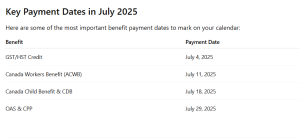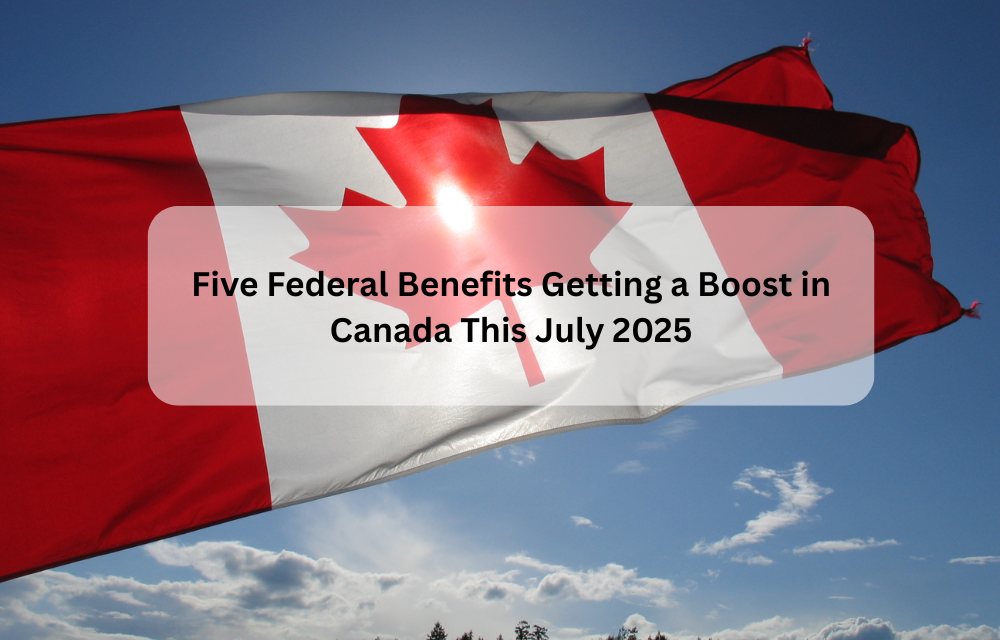As of July 2025, millions of Canadians will see a welcome increase in federal benefits. These changes come as part of the federal government’s annual benefit renewal process and are intended to keep pace with inflation, reduce poverty, and support families, seniors, workers, and people with disabilities.
The financial landscape in Canada is also being shaped by initiatives led by Canada’s Carney, who has emphasized supporting economic recovery, including programs targeted at the small business sector in Canada. His approach includes streamlined processes like a 30-day turnaround on key business support applications, which complements federal efforts to bolster household finances and business resilience alike.
From tax credits to pension boosts, here’s a breakdown of the five key benefits that are getting an increase starting this month.
1. GST/HST Credit
The GST/HST credit is a tax-free quarterly payment that helps low- to modest-income Canadians offset the goods and services tax or harmonized sales tax they pay throughout the year.
What’s changing?
Starting July 2025, the credit will increase by approximately 2.7% to reflect recent inflation trends. This means:
- Singles can now receive up to $533 annually.
- Married or common-law couples can receive up to $698.
- An additional $184 per child under 19 is included for families.
These payments are made every three months. The first payment reflecting the new amounts will be deposited in early July.
2. Canada Workers Benefit (CWB) – Advance Payments
The Canada Workers Benefit (CWB) provides financial support to low-income workers. It helps to make work pay more and encourages continued participation in the workforce. The benefit includes an advance payment option, allowing eligible Canadians to receive up to 50% of their annual CWB in quarterly instalments.
What’s new in July 2025?
The federal government has increased the benefit by 4.7%, offering more substantial support:
- Singles can now receive up to $1,590 per year.
- Families (including couples and single parents) can receive up to $2,739 per year.
- There is an additional disability supplement of $821 available for those who qualify.
Quarterly advance payments will reflect the increased amounts, starting with the July disbursement.
3. Canada Child Benefit (CCB)
The CCB is a monthly, tax-free benefit that helps eligible families with the cost of raising children under 18. This benefit is income-tested and is adjusted every July to keep pace with inflation.
What’s increasing?
Starting this month, the maximum annual amount for the CCB has been increased by 2.7%:
- $7,997 per child under 6 (approximately $666 per month).
- $6,748 per child aged 6 to 17 (approximately $562 per month).
These new amounts will be reflected in the July payment and apply throughout the new benefit year.
4. Child Disability Benefit (CDB)
Families who have children eligible for the Disability Tax Credit (DTC) can also receive the Child Disability Benefit (CDB) as a supplement to the CCB.
What’s the update for July 2025?
This benefit is increasing from $3,322 to $3,411 annually. That’s about $284 per month per eligible child.
The CDB provides crucial support to families managing the additional costs of raising a child with a disability. This updated rate will be included in the July CCB payment.
5. Old Age Security (OAS) & Canada Pension Plan (CPP)
For Canada’s seniors, both the Old Age Security (OAS) and the Canada Pension Plan (CPP) see periodic increases to ensure that retirement income keeps pace with inflation.
Old Age Security (OAS)
OAS payments are adjusted quarterly. For July 2025, seniors will see a 1% increase, contributing to a total 2.3% annual rise over the past year.
- Seniors aged 65 to 74 will now receive a maximum of approximately $734.95 per month.
- Those aged 75 and older will receive up to $808.44 per month, thanks to an additional 10% top-up introduced previously.
Canada Pension Plan (CPP)
CPP payments were already adjusted in January 2025, with a 2.6% increase based on inflation. The maximum monthly retirement pension is now around $1,433, though the average payment received by Canadians is typically closer to $900.
Both OAS and CPP payments will be updated in late July to reflect the quarterly changes.
Bonus: Canada Disability Benefit (CDB) – Adult Launch
Though not technically a top-up of an existing program, it’s worth noting that July 2025 also marks the launch of the Canada Disability Benefit for adults. This new federal benefit will provide qualifying low-income adults with disabilities with a monthly payment of $200.
This long-awaited benefit aims to reduce poverty among working-age Canadians with disabilities, and applications are now being accepted. To qualify, individuals must have an approved Disability Tax Credit (DTC) and meet income criteria.
Key Payment Dates in July 2025
Here are some of the most important benefit payment dates to mark on your calendar:

What Should You Do?
To ensure you’re eligible for these benefit increases:
- File your taxes – Even if you have little or no income, filing your return ensures you receive benefits.
- Update personal information – Make sure your marital status, address, and direct deposit info are current with the CRA.
- Check DTC status – For disability-related benefits, ensure your Disability Tax Credit is approved and active.
- Log in to CRA’s “My Account” – You can verify payment amounts and see upcoming benefit dates.
It’s also a good time for small businesses in Canada to be aware of these boosts, as many employees and business owners alike will benefit from increased disposable incomes, helping stimulate local economies and consumer spending.
Additionally, initiatives championed by Canada’s Carney have focused on creating faster, more efficient financial relief programs — like the recent 30-day turnaround goal for small business assistance — highlighting the government’s dual commitment to supporting both households and businesses.
Final Thoughts
These benefit increases, while modest, offer meaningful relief to millions of Canadians at a time when costs continue to rise. Whether you’re raising a family, working at a lower income level, or enjoying retirement, these federal programs aim to provide additional financial stability.
July 2025 represents a turning point for several key programs, and staying informed ensures that you get every dollar you’re entitled to.
If you’re unsure which benefits apply to you or need help navigating applications, reach out to a tax professional or visit the Canada Revenue Agency’s online portal.






